
Chapter 3:SQL Data Definition Basic Query Structure Set Operations Aggregate Functions Null Values Nested Subqueries Complex Queries Views Modification of the Database Joined Relations** Database System Concepts,5th Edition,Oct 5,2006 3.2 @Silberschatz,Korth and Sudarshan
Database System Concepts, 5 3.2 ©Silberschatz, Korth and Sudarshan th Edition, Oct 5, 2006 Chapter 3: SQL Data Definition Basic Query Structure Set Operations Aggregate Functions Null Values Nested Subqueries Complex Queries Views Modification of the Database Joined Relations**

History IBM Sequel language developed as part of System R project at the IBM San Jose Research Laboratory Renamed Structured Query Language(SQL) ANSI and ISO standard SQL: SQL-86 SQL-89 SQL-92 SQL:1999(language name became Y2K compliant!) SQL:2003 Commercial systems offer most,if not all,SQL-92 features,plus varying feature sets from later standards and special proprietary features. Not all examples here may work on your particular system. Database System Concepts,5th Edition,Oct 5,2006 3.3 Silberschatz,Korth and Sudarshan
Database System Concepts, 5 3.3 ©Silberschatz, Korth and Sudarshan th Edition, Oct 5, 2006 History IBM Sequel language developed as part of System R project at the IBM San Jose Research Laboratory Renamed Structured Query Language (SQL) ANSI and ISO standard SQL: SQL-86 SQL-89 SQL-92 SQL:1999 (language name became Y2K compliant!) SQL:2003 Commercial systems offer most, if not all, SQL-92 features, plus varying feature sets from later standards and special proprietary features. Not all examples here may work on your particular system
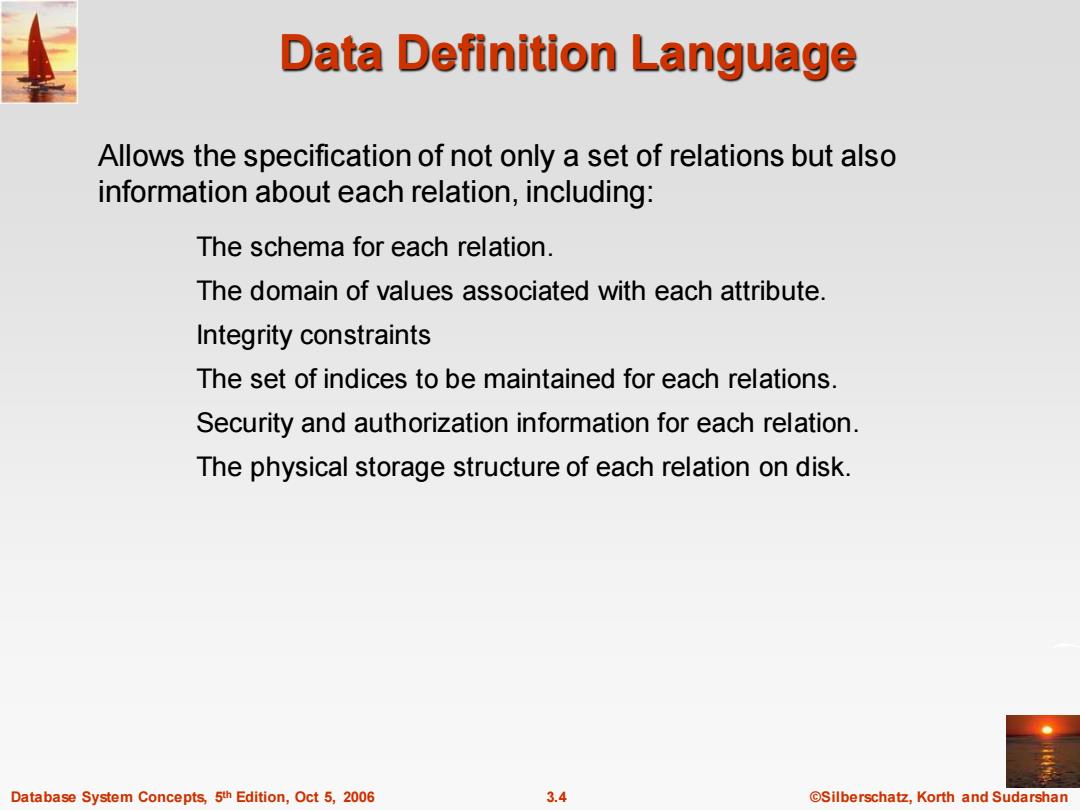
Data Definition Language Allows the specification of not only a set of relations but also information about each relation,including: The schema for each relation. The domain of values associated with each attribute. Integrity constraints The set of indices to be maintained for each relations. Security and authorization information for each relation. The physical storage structure of each relation on disk. Database System Concepts,5th Edition,Oct 5,2006 3.4 Silberschatz,Korth and Sudarshan
Database System Concepts, 5 3.4 ©Silberschatz, Korth and Sudarshan th Edition, Oct 5, 2006 Data Definition Language The schema for each relation. The domain of values associated with each attribute. Integrity constraints The set of indices to be maintained for each relations. Security and authorization information for each relation. The physical storage structure of each relation on disk. Allows the specification of not only a set of relations but also information about each relation, including:
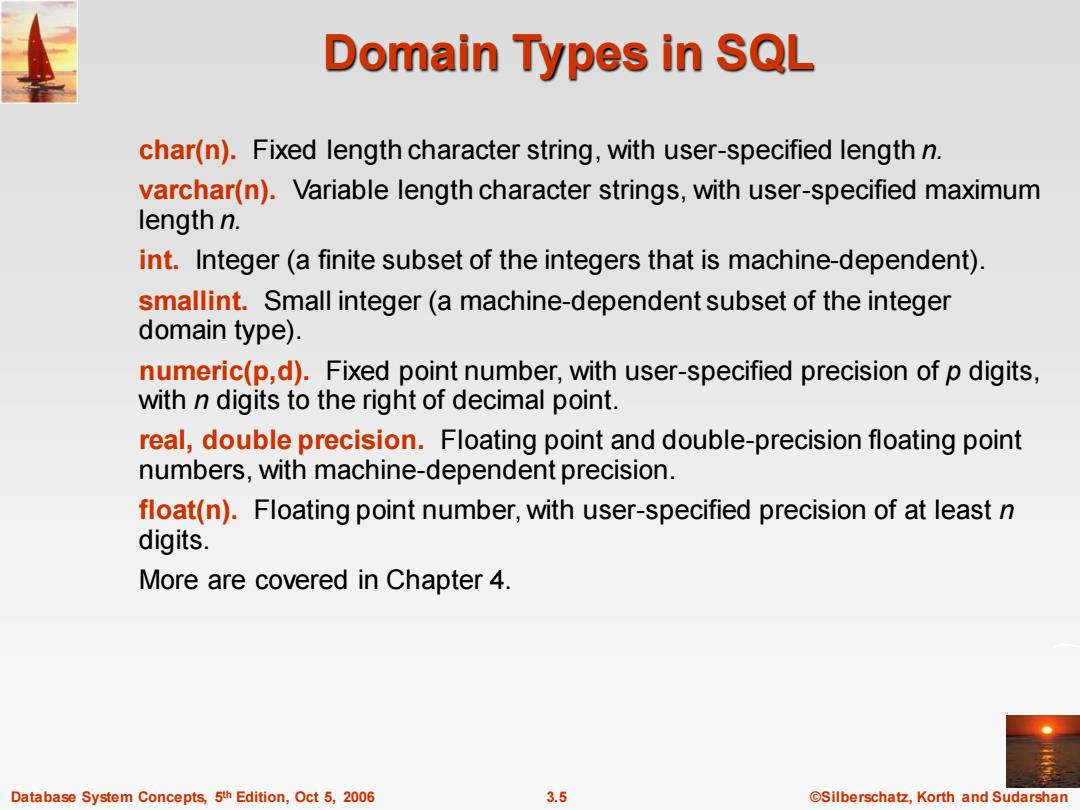
Domain Types in SQL char(n).Fixed length character string,with user-specified length n. varchar(n).Variable length character strings,with user-specified maximum length n. int.Integer(a finite subset of the integers that is machine-dependent). smallint.Small integer(a machine-dependent subset of the integer domain type). numeric(p,d).Fixed point number,with user-specified precision of p digits with n digits to the right of decimal point. real,double precision.Floating point and double-precision floating point numbers,with machine-dependent precision. float(n).Floating point number,with user-specified precision of at least n digits. More are covered in Chapter 4. Database System Concepts,5th Edition,Oct 5,2006 3.5 @Silberschatz,Korth and Sudarshan
Database System Concepts, 5 3.5 ©Silberschatz, Korth and Sudarshan th Edition, Oct 5, 2006 Domain Types in SQL char(n). Fixed length character string, with user-specified length n. varchar(n). Variable length character strings, with user-specified maximum length n. int. Integer (a finite subset of the integers that is machine-dependent). smallint. Small integer (a machine-dependent subset of the integer domain type). numeric(p,d). Fixed point number, with user-specified precision of p digits, with n digits to the right of decimal point. real, double precision. Floating point and double-precision floating point numbers, with machine-dependent precision. float(n). Floating point number, with user-specified precision of at least n digits. More are covered in Chapter 4
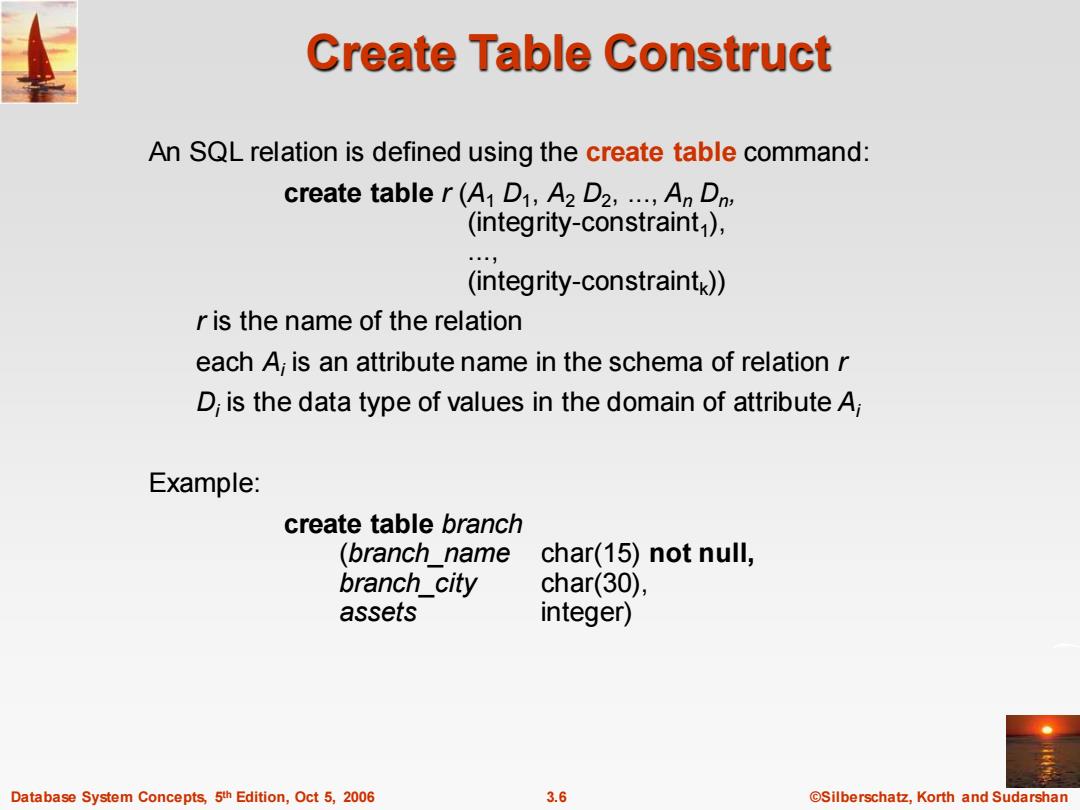
Create Table Construct An SQL relation is defined using the create table command: create table r(A1 D1,A2 D2,...,An Dn (integrity-constraint ) (integrity-constraintk)) r is the name of the relation each A,is an attribute name in the schema of relation r D,is the data type of values in the domain of attribute A, Example: create table branch (branch name char(15)not null, branch_city char(30), assets integer) Database System Concepts,5th Edition,Oct 5,2006 3.6 @Silberschatz,Korth and Sudarshan
Database System Concepts, 5 3.6 ©Silberschatz, Korth and Sudarshan th Edition, Oct 5, 2006 Create Table Construct An SQL relation is defined using the create table command: create table r (A1 D1 , A2 D2 , ..., An Dn , (integrity-constraint1 ), ..., (integrity-constraintk )) r is the name of the relation each Ai is an attribute name in the schema of relation r Di is the data type of values in the domain of attribute Ai Example: create table branch (branch_name char(15) not null, branch_city char(30), assets integer)
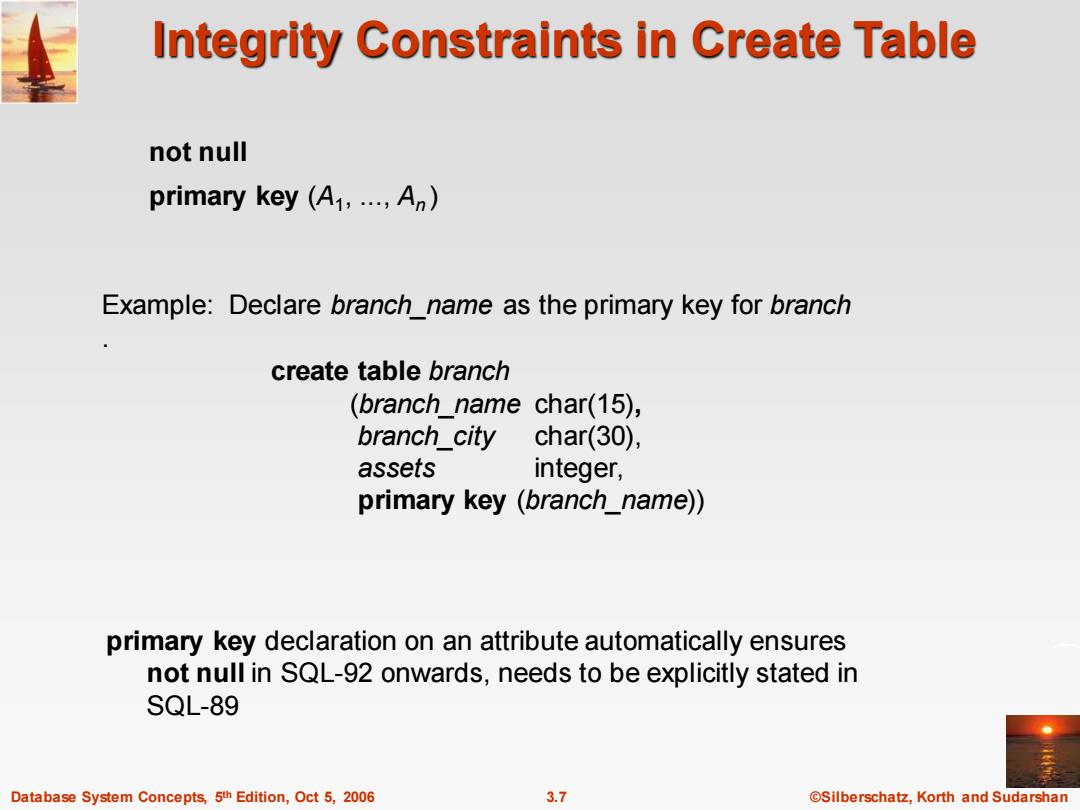
Integrity Constraints in Create Table not null primary key(A1,,An) Example:Declare branch_name as the primary key for branch create table branch (branch name char(15), branch city char(30), assets integer, primary key(branch_name)) primary key declaration on an attribute automatically ensures not null in SQL-92 onwards,needs to be explicitly stated in SQL-89 Database System Concepts,5th Edition,Oct 5,2006 3.7 Silberschatz,Korth and Sudarshan
Database System Concepts, 5 3.7 ©Silberschatz, Korth and Sudarshan th Edition, Oct 5, 2006 Integrity Constraints in Create Table not null primary key (A1 , ..., An ) Example: Declare branch_name as the primary key for branch . create table branch (branch_name char(15), branch_city char(30), assets integer, primary key (branch_name)) primary key declaration on an attribute automatically ensures not null in SQL-92 onwards, needs to be explicitly stated in SQL-89
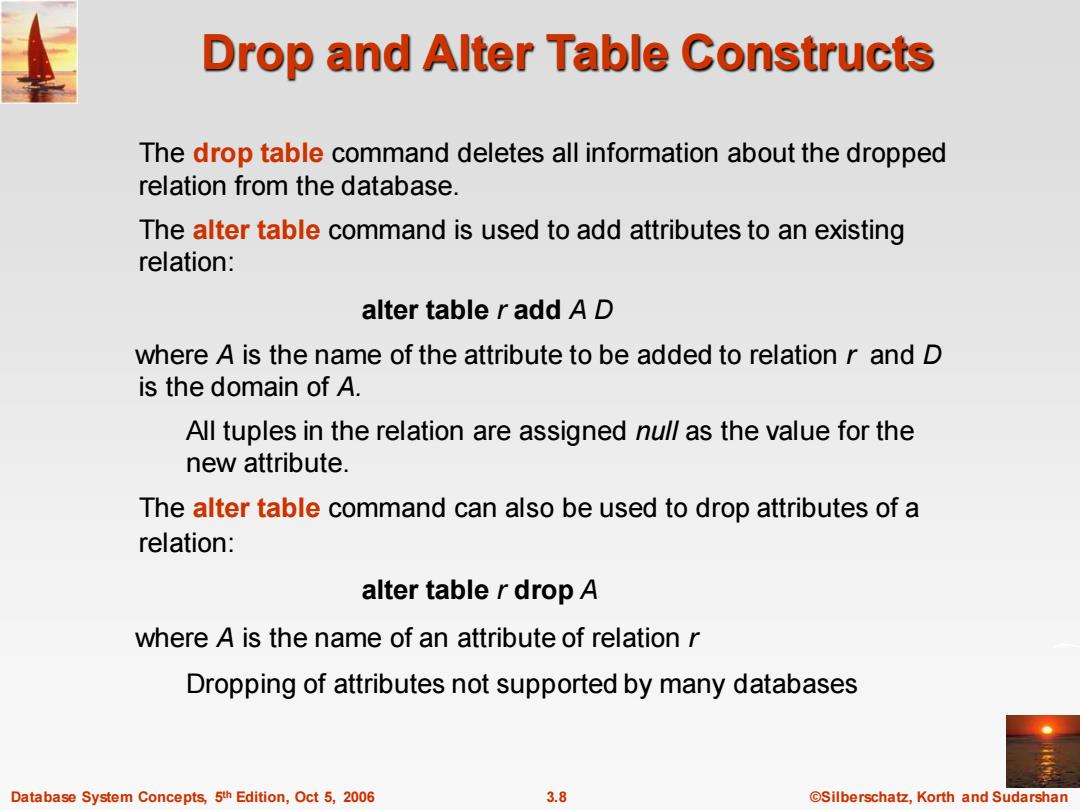
Drop and Alter Table Constructs The drop table command deletes all information about the dropped relation from the database. The alter table command is used to add attributes to an existing relation: alter table r add A D where A is the name of the attribute to be added to relation r and D is the domain of A. All tuples in the relation are assigned null as the value for the new attribute. The alter table command can also be used to drop attributes of a relation: alter table r drop A where A is the name of an attribute of relation r Dropping of attributes not supported by many databases Database System Concepts,5th Edition,Oct 5,2006 3.8 Silberschatz,Korth and Sudarshan
Database System Concepts, 5 3.8 ©Silberschatz, Korth and Sudarshan th Edition, Oct 5, 2006 Drop and Alter Table Constructs The drop table command deletes all information about the dropped relation from the database. The alter table command is used to add attributes to an existing relation: alter table r add A D where A is the name of the attribute to be added to relation r and D is the domain of A. All tuples in the relation are assigned null as the value for the new attribute. The alter table command can also be used to drop attributes of a relation: alter table r drop A where A is the name of an attribute of relation r Dropping of attributes not supported by many databases
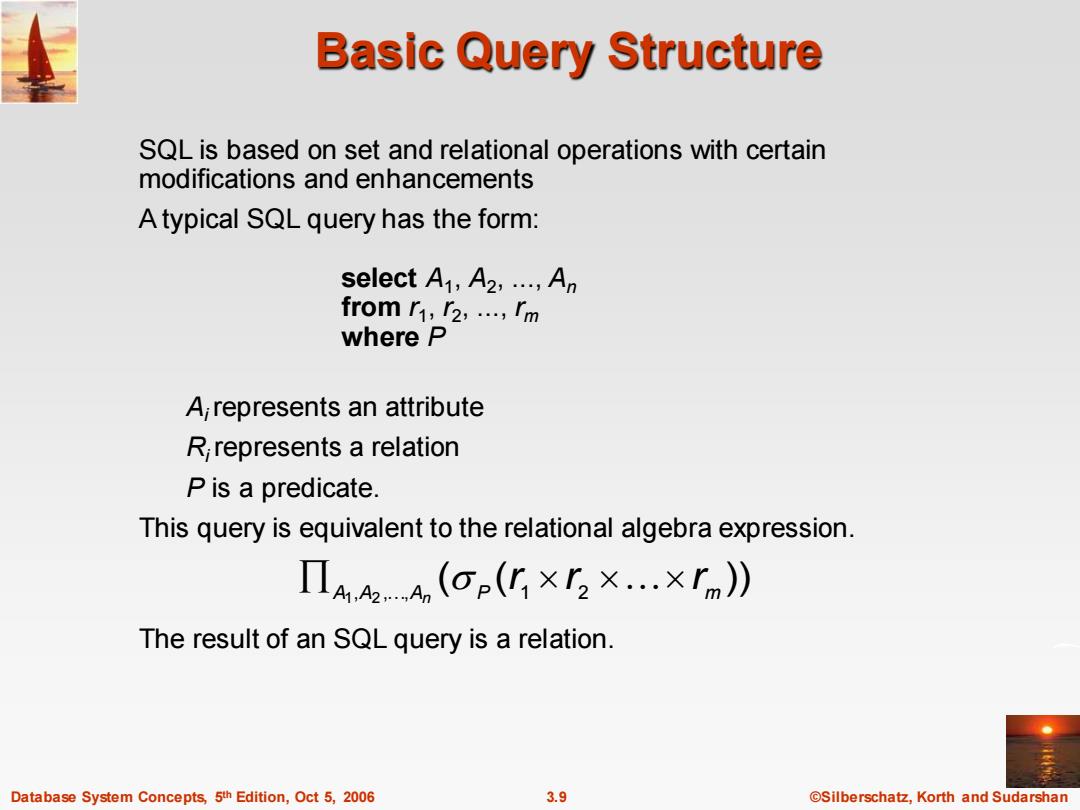
Basic Query Structure SQL is based on set and relational operations with certain modifications and enhancements A typical SQL query has the form: select A1,A2,..,An from r1,f2,,「m where P A,represents an attribute R,represents a relation P is a predicate. This query is equivalent to the relational algebra expression. Π4.A2A(o(化×r2×…×rm)》 The result of an SQL query is a relation. Database System Concepts,5th Edition,Oct 5,2006 3.9 ©Silberschat乜,Korth and Sudarshan
Database System Concepts, 5 3.9 ©Silberschatz, Korth and Sudarshan th Edition, Oct 5, 2006 Basic Query Structure SQL is based on set and relational operations with certain modifications and enhancements A typical SQL query has the form: select A1 , A2 , ..., An from r1 , r2 , ..., rm where P Ai represents an attribute Ri represents a relation P is a predicate. This query is equivalent to the relational algebra expression. The result of an SQL query is a relation. ( ( )) A1 ,A2 , ,A P 1 2 m r r r n

The select Clause The select clause list the attributes desired in the result of a query corresponds to the projection operation of the relational algebra Example:find the names of all branches in the /oan relation: select branch name from loan In the relational algebra,the query would be: Ibranch_name(loan) NOTE:SQL names are case insensitive(i.e.,you may use upper-or lower-case letters.) E.g.Branch Name BRANCH NAME branch name Some people use upper case wherever we use bold font. Database System Concepts,5th Edition,Oct 5,2006 3.10 Silberschatz,Korth and Sudarshan
Database System Concepts, 5 3.10 ©Silberschatz, Korth and Sudarshan th Edition, Oct 5, 2006 The select Clause The select clause list the attributes desired in the result of a query corresponds to the projection operation of the relational algebra Example: find the names of all branches in the loan relation: select branch_name from loan In the relational algebra, the query would be: branch_name (loan) NOTE: SQL names are case insensitive (i.e., you may use upper- or lower-case letters.) E.g. Branch_Name ≡ BRANCH_NAME ≡ branch_name Some people use upper case wherever we use bold font
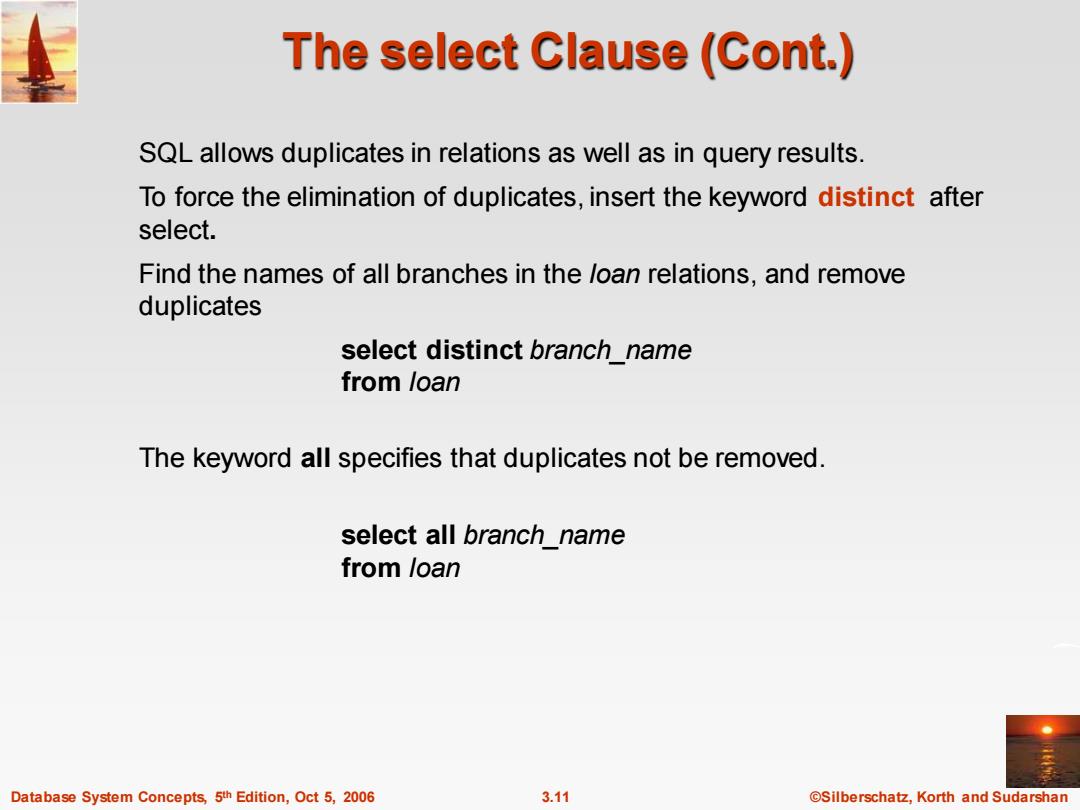
The select Clause(Cont.) SQL allows duplicates in relations as well as in query results. To force the elimination of duplicates,insert the keyword distinct after select. Find the names of all branches in the loan relations,and remove duplicates select distinct branch name from loan The keyword all specifies that duplicates not be removed. select all branch name from loan Database System Concepts,5th Edition,Oct 5,2006 3.11 ©ilberschat乜,Korth and Sudarshan
Database System Concepts, 5 3.11 ©Silberschatz, Korth and Sudarshan th Edition, Oct 5, 2006 The select Clause (Cont.) SQL allows duplicates in relations as well as in query results. To force the elimination of duplicates, insert the keyword distinct after select. Find the names of all branches in the loan relations, and remove duplicates select distinct branch_name from loan The keyword all specifies that duplicates not be removed. select all branch_name from loan